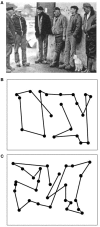The contribution of LM to the neuroscience of movement vision
- PMID: 25741251
- PMCID: PMC4330684
- DOI: 10.3389/fnint.2015.00006
The contribution of LM to the neuroscience of movement vision
Abstract
The significance of early and sporadic reports in the 19th century of impairments of motion vision following brain damage was largely unrecognized. In the absence of satisfactory post-mortem evidence, impairments were interpreted as the consequence of a more general disturbance resulting from brain damage, the location and extent of which was unknown. Moreover, evidence that movement constituted a special visual perception and may be selectively spared was similarly dismissed. Such skepticism derived from a reluctance to acknowledge that the neural substrates of visual perception may not be confined to primary visual cortex. This view did not persist. First, it was realized that visual movement perception does not depend simply on the analysis of spatial displacements and temporal intervals, but represents a specific visual movement sensation. Second persuasive evidence for functional specialization in extrastriate cortex, and notably the discovery of cortical area V5/MT, suggested a separate region specialized for motion processing. Shortly thereafter the remarkable case of patient LM was published, providing compelling evidence for a selective and specific loss of movement vision. The case is reviewed here, along with an assessment of its contribution to visual neuroscience.
Keywords: akinetopsia; cerebral motion blindness; movement vision; patient LM.
Figures






Similar articles
-
The effect of target speed on perception of visual motion direction in a patient with akinetopsia.Cortex. 2019 Oct;119:511-518. doi: 10.1016/j.cortex.2018.12.002. Epub 2018 Dec 15. Cortex. 2019. PMID: 30661737
-
Direction-specific motion blindness induced by focal stimulation of human extrastriate cortex.Eur J Neurosci. 2002 Jun;15(12):2043-8. doi: 10.1046/j.1460-9568.2002.02038.x. Eur J Neurosci. 2002. PMID: 12099910
-
Motion area V5/MT+ response to global motion in the absence of V1 resembles early visual cortex.Brain. 2015 Jan;138(Pt 1):164-78. doi: 10.1093/brain/awu328. Epub 2014 Nov 28. Brain. 2015. PMID: 25433915 Free PMC article.
-
Cerebral akinetopsia (visual motion blindness). A review.Brain. 1991 Apr;114 ( Pt 2):811-24. doi: 10.1093/brain/114.2.811. Brain. 1991. PMID: 2043951 Review.
-
Akinetopsia: a systematic review on visual motion blindness.Front Neurol. 2025 Feb 10;15:1510807. doi: 10.3389/fneur.2024.1510807. eCollection 2024. Front Neurol. 2025. PMID: 39996018 Free PMC article.
Cited by
-
Activation of the Human MT Complex by Motion in Depth Induced by a Moving Cast Shadow.PLoS One. 2016 Sep 6;11(9):e0162555. doi: 10.1371/journal.pone.0162555. eCollection 2016. PLoS One. 2016. PMID: 27597999 Free PMC article.
-
Children with cerebral palsy display altered neural oscillations within the visual MT/V5 cortices.Neuroimage Clin. 2019;23:101876. doi: 10.1016/j.nicl.2019.101876. Epub 2019 May 28. Neuroimage Clin. 2019. PMID: 31176292 Free PMC article.
-
Two Visual Pathways in Primates Based on Sampling of Space: Exploitation and Exploration of Visual Information.Front Integr Neurosci. 2016 Nov 22;10:37. doi: 10.3389/fnint.2016.00037. eCollection 2016. Front Integr Neurosci. 2016. PMID: 27920670 Free PMC article.
-
Life in stop motion: a review of akinetopsia.Orphanet J Rare Dis. 2025 Jul 2;20(1):334. doi: 10.1186/s13023-025-03781-6. Orphanet J Rare Dis. 2025. PMID: 40605075 Free PMC article. Review.
-
Event as the central construal of psychological time in humans.Front Psychol. 2024 Sep 18;15:1402903. doi: 10.3389/fpsyg.2024.1402903. eCollection 2024. Front Psychol. 2024. PMID: 39359968 Free PMC article. Review.
References
Publication types
LinkOut - more resources
Full Text Sources
Other Literature Sources

